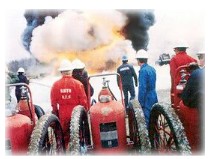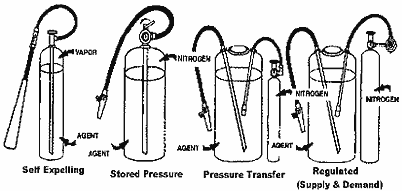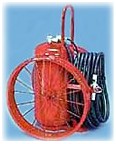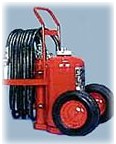|
Over the past 40 years, the demand for transportation,
storage, and handling of flammable fuels that fall under the
fire protection classification of "High Hazard"
has increased drastically. This has often occurred at a
faster rate than most fire protection requirements or
coverages. Recent trends toward automation and work force
reductions have placed additional demands upon fast response
types of fire fighting equipment. With fewer people
available to respond to emergency situations where higher
fire loads exist, portable wheeled fire extinguishers that
provide a quicker, more effective extinguishment solution
than water, should be utilized.
|
Portable
wheeled fire extinguishers have been around for well
over 50 years and were, in those early years,
referred to as "Wheeled Engines". The
first true market niche for this equipment was
established during the early 1940s when it was used
to protect military airport ramps.
Wheeled
extinguishers can be easily operated by one person
and are considered to be portable extinguishers
falling under The National Fire Protection
Association's Standard NFPA-10. |

|
The
portable "wheeled" units are differentiated from
"hand portable" types often simply on the basis of
their capacity or total weight. For example, the portable
extinguisher design standard for dry chemical extinguishers
ANSI/UL-299 specifies that hand portable models not have a
total charged gross weight exceeding 60 pounds.
Wheeled units are available in a variety of model sizes that
feature extinguishing agents such as carbon dioxide, dry
chemical, halons, dry powder, and AFFF-type foam pre-mix
solutions. Agent capacities of 30 to 350 pounds are offered,
with many of the smaller-sized units sometimes being
glorified hand portables on wheels marketed to meet minimum
high hazard requirements or for added ease of mobility.
Basic
Extinguisher Operation Principles - NAFED
The
primary fire protection value of wheeled fire extinguishers
is in their ability to:
-
Contain
greater extinguishing agent capacities
-
Deliver
higher agent flow rates
-
Provide
additional fire fighting ranges
-
Extend
discharge times.
These
unique fire fighting characteristics are also extremely
valuable during emergency situations in providing assistance
to various rescue and evacuation efforts.

Basic
Extinguisher Operation Principles
|

|
There
are basically four operation principles in which wheeled
extinguishers are designed and manufactured.
Self-Expelling:
These models typically contain the extinguishing agent
within a single high-pressure cylinder. When the cylinder
valve is opened, the extinguishing agent's own vapor
pressure forces the agent to travel up a pick-up tube,
through the operating valve and out the discharge hose
nozzle valve onto the fire. This principle is primarily
limited to carbon dioxide wheeled models which are not
equipped with pressure gauges to indicate charge status. |
|
(Buckeye)
50 lb.
Carbon Dioxide
"Self Expelling" Mode |
Stored
Pressure: With this principle, the extinguishing agent
and expellant gas source (normally super pressurized
nitrogen) is contained within the same cylinder. Upon
actuation of an operating valve, internal pressure forces
the extinguishing agent up the pick-up tube, through the
operation valve and out the discharge hose nozzle valve on
to the fire. This configuration of hardware is normally the
least expensive.
Pressure Transfer: This concept consists of separate
extinguishing agent and expellant gas cylinders. The
expellant (normally compressed nitrogen) is contained within
a specifically engineered volume and sized high-pressure
cylinder designed to properly pressurize and discharge the
total contents of the agent cylinder. Upon opening of the
expellant gas cylinder operating valve, expellant gas is
transferred through a special gas distribution tube assembly
that fluidizes and pressurizes the agent cylinder to a
pre-determined head pressure. This pressure permits the
extinguishing agent to travel up the agent tank pick-up tube
and out the discharge nozzle valve on to the fire. This
concept is less susceptible to vibration pressure losses in
rugged and abusive environments. The separate unpressurized
agent cylinder allows simple agent examination and quick
recharges in the field.
Regulated Supply and Demand: While similar to the
pressure transfer principle in most ways, this concept
utilizes a much larger volume expellant gas cylinder source
and a pressure regulator. As the extinguishing agent is
discharged, the regulator will flow and meter additional
expellant gas pressure to the agent tank, providing a more
consistent operating pressure. This ensures stable agent
flow rates and ranges throughout the fire fighting evolution.
While usually higher priced, many fire hazards justify the
additional cost associated with the regulator and larger gas
cylinder necessary on these models.
Extinguisher
Options
There
are a large variety of options available to wheeled
extinguishers, with the nozzle design and wheel
configuration being two of the most often misunderstood and
incorrectly applied.
Wheel diameters of 16 to 44 inches are commonly offered in
various widths and finished rolling surface bases. The large
diameter wheel types will provide superior mobility and ease
of operation over uneven surfaces like potholes,
|

|
sidewalks
or small steps. Wide 6-inch wheel bases provide additional
versatility on soft surfaces such as loose sand, gravel or
sod. When spark reduction or the marking of floor finishes
is a consideration, the pneumatic, semi-pneumatic and
rubber-banded wheels should be utilized rather than the
steel base types. Because pneumatic wheels will absorb some
surface shock, they generally deliver the best unit ride and
are often selected for large airport ramp areas where towing
operations exist. The semi-pneumatic and rubber-banded
wheels eliminate potential flat problems in and around areas
where sharp objects may be present.
Before purchasing any unit, always check to ensure the
overall width of the unit, under its specific wheel option
configuration, will fit through any necessary aisles or door
passageways.
The nozzle design of the wheeled extinguisher directly
contributes to various operation characteristics such as the
discharge range, pattern, velocity, flow rate and fire
rating.
Range information published by manufacturers can often be
somewhat misleading. The focus here should be on the unit's
"effective range" established through actual
fire-fighting evolutions, subject to thermal up- draft
factors. Different internal nozzle bore designs provide
various agent stream patterns, flow rates and velocities.
Discharge characteristics should be properly matched to the
particular fire hazard. For example, the venturi designs
generally provide higher velocities and ranges at lower
agent flow rates, which work well on large class
"A" fire applications. On the other hand,
cone-type nozzle designs normally reduce agent velocity for
a softer discharge, making them ideal around fuel-in-depth
situations where splashing of fuels in, and around, confined
areas could present problems to firefighters.
Equipment specifiers should also keep in mind that the
portable extinguisher class "B" rating system is
based on minimum discharge times and only one type of fire
configuration. For the manufacturers to obtain higher and
more impressive ratings, they must increase discharge times
by cutting back agent flow rates, which is detrimental to
the extinguishment of many other common industry class
"B" fire configurations. Agent flow rates become
critical in obstacle, gravity, 3-dimensional and pressure
fire configurations. The NFPA 10 standard recognizes this
and specifically states under several such hazard areas that
"The system used to rate extinguishers on class
"B" fires is not directly applicable to these
types of hazards." For most wheel unit applications,
higher attention to the agent flow rates over extinguisher
ratings is in order. Most manufacturers can provide
recommendations and furnish support data.
Maintenance
Wheeled
fire extinguishers, like hand portable models, are
mechanical devices that require periodic service for optimum
performance and reliability. Both OSHA and NFPA requirements
specify maximum extinguisher inspection intervals of 30 days
and for maintenance to be performed at least annually.
Training
When
properly selected and maintained, wheeled fire extinguishers
provide an exceptional fire fighting resource for the high
risk industries of today. For companies to benefit and reap
the full potential of these extremely effective units,
training programs properly designed to demonstrate and
familiarize operators with their impressive capabilities
should also be regularly conducted.
|